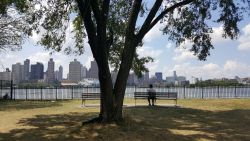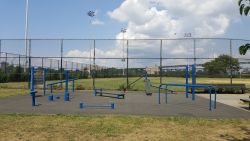Whitey Ford Field
Whitey Ford Field
What was here before?
This site was occupied by Eagle Oil Works in the late 19th century, before the City acquired the land in February 1906 from the Board of Education. In 1907, the U.S. Government leased part of the site for a monthly fee of $16.66 to the Coast Guard so they could maintain a lighthouse and bell along the water at the site. The lighthouse remained on the seawall until 1982, when it began to lean. The Coast Guard determined that the most cost-effective solution would be to create a new light, and it was relocated to a light stanchion on the field.
How did this site become a park?
In 1942, NYC Parks Commissioner Robert Moses (1888-1981) petitioned the City to assign this property to Parks after the Board of Education stopped using the facility. Well maintained, the field already had a baseball diamond, running track, and grandstand and needed only minor repairs. Moses argued that the site was necessary in this section of Queens, as the neighborhood lacked adequate opportunities for baseball and other forms of “adult recreation.” In October of 1943, the site was assigned to Parks and became known as Astoria Athletic Field.
In 1985, the park’s name was changed to Hellgate Field for the water passage that the park abuts. In 2021, the facility was upgraded with natural grass turf and new dugouts in addition to a reconstructed entrance from Second Street and new amenities like fitness equipment, picnic tables, drinking fountains, and seating areas to the site.
Who is this field named for?
At a special Yankee Stadium ceremony in August 2000, the field was dedicated to legendary Yankees pitcher and Astoria native Whitey Ford (1928-2020).
Born Edward Charles Ford on October 21, 1928 on Manhattan’s Upper East Side, Ford was raised in Astoria. Because the local William Cullen Bryant High School did not have a baseball team, he attended Manhattan High School of Aviation Trades where he played first base. He tried out for the Yankees in the spring of his senior year of high school and signed with them that October as a pitching prospect.
Ford was called up to the majors in 1950, beginning a long and illustrious career with the team, though he missed the 1951 and 1952 seasons while serving in the United States Army during the Korean War. During his time with the Yankees, the team won 236 games, including 11 pennants and six World Series. He was a ten-time All Star and in 1961 he received the Cy Young Award and World Series MVP. He earned the nickname “Chairman of the Board” for his calm, collected demeanor and pitching style.
Following his retirement in 1967, Ford served brief stints as the team’s first base and pitching coach and assisted at spring training. His Jersey, number 16, was retired when Ford was inducted into baseball Hall of Fame in 1974. He was the first Yankee pitcher to have his jersey retired.
Check out your park's Vital Signs
Clean & Safe
Green & Resilient
Empowered & Engaged Users
Share your feedback or learn more about how this park is part of a
Vital Park System





